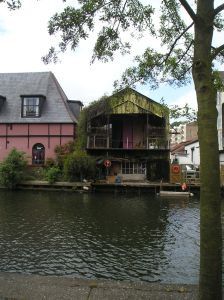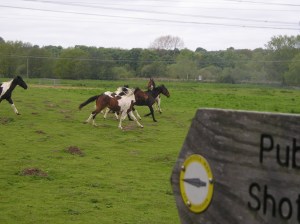Eight years ago, my friend Winston and I made a brave attempt at the Peddars Way and North Norfolk Coastal Path. Our failure to complete it had everything to do with poor planning, late starts and having to shelter from torrential rain in phone boxes. That time we were walking west to east, finally throwing in the towel at Blakeney.

It was therefore with a sense of unfinished business that Winston and I (veterans of that first adventure) joined this time by my brothers Russ and Joe, set off to tackle the route from east to west.

We’re doing it properly, with sleeping bags and tents – and we are a distinctive sight with my round pop-up tent strapped to my back. It’s a cross between a chieftain’s shield, a tortoise shell and a radar dish and fellow walkers invariably make these comparisons as we encounter them on the route.

We begin in Overstrand, a delightful spot in the heart of Poppyland, a little ahead of the official starting line of the coastal path in Cromer. Overstrand used to be known as the ‘village of millionaires‘, and was fashionable for a while as the holiday destination of Winston Churchill. It still has more than its fair share of handsome Victorian architecture for a village of its size and a beautiful sandy beach. Anyone in the know looking for a quiet place for a swim, a snooze and quiet read will make for this instead of the giddy glamour of Cromer. Today unfortunately its just as famous as a village gradually slipping into the sea. A local joke runs that there used to be another village further out, now submerged by the sea, called Understrand . . .

The path runs just feet away from the cliff’s edge, lined with brambles and wild flowers. The nettles and poppies brush at your ankles, and you need to watch your step to avoid being stung. At times a piece of the path appears to disappear. A glance over the edge and you see the cliff falls on the beach below. But why does it crumble so easily? The sea spray gets into the cliff, weakening the earth; the wind does the rest hauling it down in great chunks onto the beach.
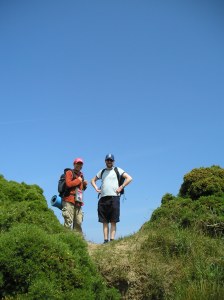
The wildness of the path contrasts with the prim perfection of the golf course, over whose land the path runs (they remind you that it is a privilege for us to walk across their land and it raises all sorts of moral questions about who actually owns the coast anyway.)
We pass a white lighthouse which continues to blink and flash throughout the day and night; it has a Great Gatsby-like quality, and for much of the day we can see it as we look back. On the far horizon we see Beeston Bump, beyond Cromer, like a mini Glastonbury Tor on the horizon.

The Blogg memorial to the famous lifeboat man is a must have photo opportunity for anyone with a blog – he is credited with saving an astonishing 873 lives over 53 years of service. We duly line up next to him . . . He had a splendid nose as you can see.

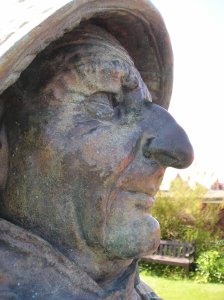
Cromer is full of the usual pleasures – the impressive high church tower, covered in local stone, the haphazard Victorian architecture, crab sandwiches. Winston dives in for some seafood at the earliest opportunity.

We are accosted outside the church by a man with an owl – working for local conservation charity and they become temporary members of the Fantastic Four.

Past the pier, just repaired after the winter storm surge and the path veers inland. We follow a muddy trail that takes us past fields of horses, deserted farms and campsites tucked away in the trees.
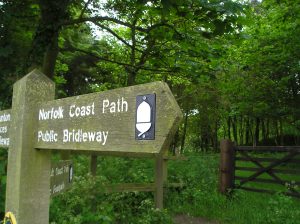
A strange cairn, covered in rocks from the beach turns into an opportunity for some excellent Dalek impressions.

Rejoining the coast at Beeston Regis, we go up and over the famous bump – a complete oddity in the otherwise flat Norfolk landscape, that gives us an opportunity to look back on the ground covered so far.
Sheringham, home at different times to both Michael Palin and Vaughn Williams, is full of charm. It is undergoing a gradual gentrification although at the moment there is an almost perfect balance of old fashioned seaside treats and green welly boutiques.
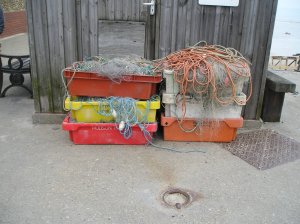
There are plenty of curiosity shops, a truly unique museum and best of all, perhaps the most astounding choice of ice cream this side of Venice. Jaffa Cake or Jam Donut ice cream anyone? I find a few old copies of The Scout from the 1960s – ten for a pound!

We have lunch on the pebbly beach, after which Joe and Chris perform their famous Russian jugglers routine: The Brothers Potenkin, where Joe shows his prowess at stone age juggling: ie: throwing rocks into the air and catching them again. The golden day has become rather more overcast and we abort the planned sea swim partly due to the cold and partly due to danger of chafing later in the walk. . .
Russ stocks up on coffee ahead of the barren stretch ahead of us. Just before we leave the town, we meet a Romanian man in shades and high vis jacket sweeping the promenade. He asks us where we’re heading and when we mention The George at Cley, he gives us a strange message to pass to the landlord and his staff. ‘They know I’m crazy in there. Tell them I will be back.’
The path up to Weybourne is one of the best stretches. Shortly after leaving Sheringham we are treated to a classic English view: a steam train cutting through the fields, a large allotment with men snoozing next to their sheds and in the distance, twenty two men in whites playing village cricket.

We follow the grassy path which undulates dramatically, so at times we are towering high about the beach and at other are relatively close to the sea level.

The edge is ridiculously perilous with enormous rock falls lying in piles on the pebbles and you wonder how many inquisitive dogs have unwittingly flown over the edge chasing seagulls. Down on the beach we see giant sea birds sharing the coast with lonely walkers. At our eye level swifts stitch the sky, soaring and swooping around each other.
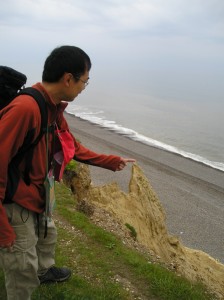
The short terrace of houses at Weybourne, just down from windmill, is a famous sight on the coastal path – and is at once inspiring and melancholy; sure as eggs are eggs, these houses will all be in the sea in thirty years time.
As we pass the Muckleburgh collection – a war museum, we pass speeding jeeps and a group of cadets in combat fatigues chilling out on the beach. I’m not sure how fair it is putting twelve year olds into army uniforms, but they all seem to be enjoying themselves. But at what point does playing at war become training for war?

Around The Quags, a brilliantly named stretch of the path where the grass and sand dissolves into bog, we are finally driven onto the pebbles. Walking on these is hard work, your feet slipping back with each step and it dawns on us that we are quite behind time. Dinner is booked for eight o’clock at The George in Cley and they stop serving at nine. We slog on, breaking into different combinations, and Joe attempts some bounding to make up for lost time.
The magnificent church at Salthouse is a welcome sight although the sky is now beginning to darken.

Only by ordering dinner by phone from the path as we cross the marshes, do we save our dinner. The George at Cley-next-the-Sea is about the most welcome sight you can imagine.

Incongruously, it was here where Rupert Brooke was sitting when war was declared in 1914. The food is magnificent – giant portions and the drinkers and landlord give us the friendliest greeting, having awaited our arrival for the last hour.

The selection of ales is superb too, and we plump for a Wherry, which is a wonderfully frothy and thirst quenching local bitter. The Nelson’s Revenge, also from Woodforde’s is not be missed either.

There is a final unexpected adventure after leaving the pub. We have some rough directions to the campsite down Old Woman’s Lane, which we follow for over a mile without success. Totally exhausted, we consider pitching at the edge of a field. However having booked and paid for the campsite, Joe drives us on. We are treated to perfectly clear, star filled skies and Cassiopeia is particularly fine. Then we see what is unmistakably the International Space station swooping at considerable speed across the star-scape. It’s a terrific treat but doesn’t bring us any closer to our beds. Eventually we rummage for the address and find that the campsite is not on Old Woman’s lane at all. We finally pitch around one am and drop off around two.
The village of Cley is very beautiful, blessed with substantial, handsome houses, built by the merchants who made their fortunes from the sea ports, before the channels narrowed and big ships could no longer navigate to the village itself. It is left with a delightful selection of bookshops, galleries and pubs and the delicatessen at Cley – Picnic Fayre – is generally agreed to be one of the greatest shops on Earth. Loaded with pastries, almond slices and fresh coffees, we enjoy a breakfast feast while waiting for the Coast Hopper bus to take us back to Cromer. It’s a strange feeling covering the same ground in half an hour (for three quid) which otherwise took an entire day on foot. Swarms of cyclists in day-glow colours freewheel along the coast road, impeding progress a little, but by the time we reach Cromer, we feel a beautiful sense of achievement.

With its huge skies, dramatic bird life, lonely houses and windmills, the coastal path is one of the most memorable of our national trails. It’s the perfect blend of countryside and coast and with its churches, seaside towns and villages, it’s steeped in history too. The shoreline and slate grey seas retain an ancient air of the time the Angles first came ashore from northern Europe and claimed the ‘land of the North Folk‘ for themselves. No doubt they were as enamored by its unique atmosphere as we were.



























